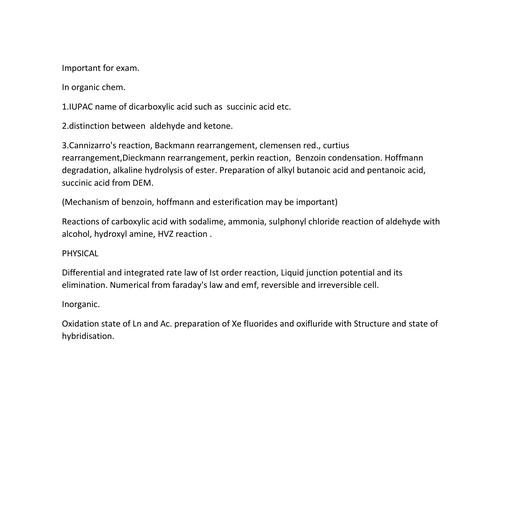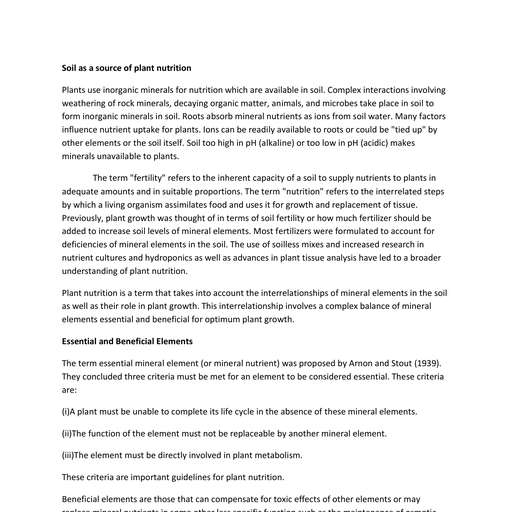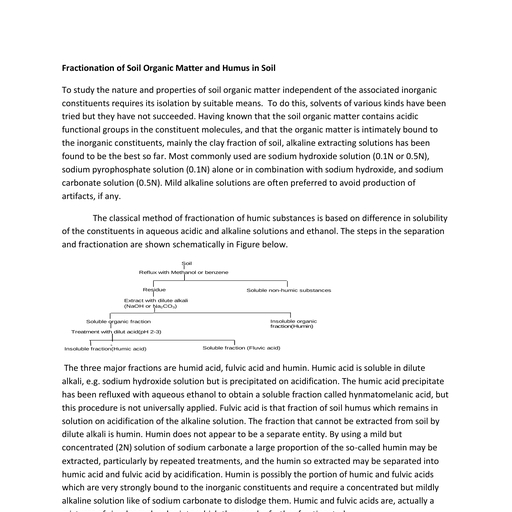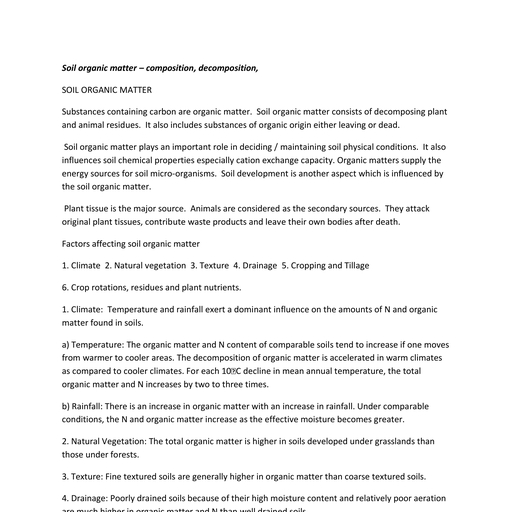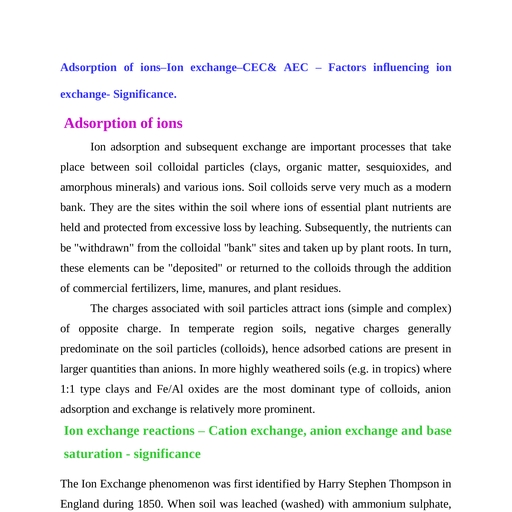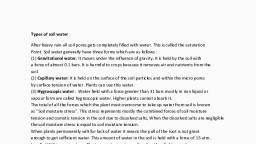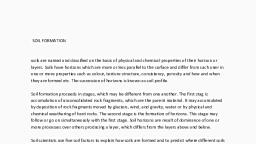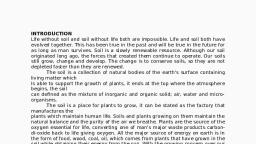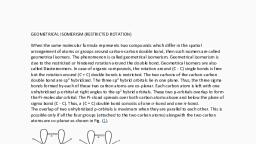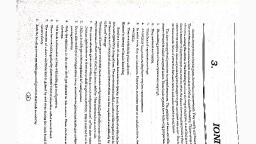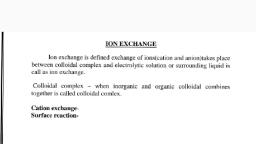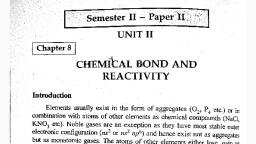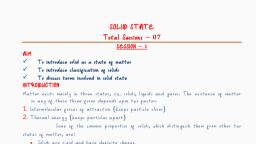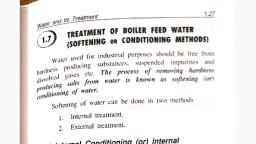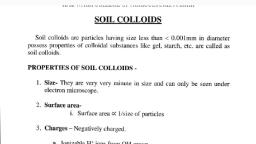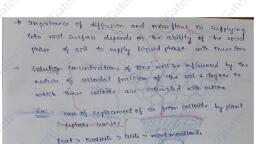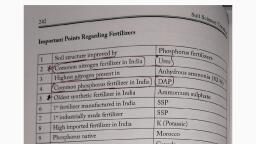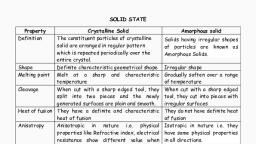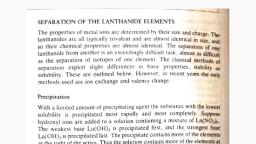Page 1 :
Adsorption of ions–Ion exchange–CEC& AEC – Factors influencing ion, exchange- Significance., , Adsorption of ions, Ion adsorption and subsequent exchange are important processes that take, place between soil colloidal particles (clays, organic matter, sesquioxides, and, amorphous minerals) and various ions. Soil colloids serve very much as a modern, bank. They are the sites within the soil where ions of essential plant nutrients are, held and protected from excessive loss by leaching. Subsequently, the nutrients can, be "withdrawn" from the colloidal "bank" sites and taken up by plant roots. In turn,, these elements can be "deposited" or returned to the colloids through the addition, of commercial fertilizers, lime, manures, and plant residues., The charges associated with soil particles attract ions (simple and complex), of opposite charge. In temperate region soils, negative charges generally, predominate on the soil particles (colloids), hence adsorbed cations are present in, larger quantities than anions. In more highly weathered soils (e.g. in tropics) where, 1:1 type clays and Fe/Al oxides are the most dominant type of colloids, anion, adsorption and exchange is relatively more prominent., , Ion exchange reactions – Cation exchange, anion exchange and base, saturation - significance, The Ion Exchange phenomenon was first identified by Harry Stephen Thompson in, England during 1850. When soil was leached (washed) with ammonium sulphate,, calcium sulphate was detected in the leachate. The ammonium ion in the solution, replaced calcium in the soil., (NH4)2SO4 + Soil Ca, , Soil (NH4)2 + CaSO4
Page 2 :
The process by which ions are exchanged between solid and liquid phases, and /or between solid phases if in close contact with each other is called ion, exchange., The common exchangeable cations are Ca2+ mg2+ H+ ,K+, NH4, , +, , and Na., , The common anions are So4 2-, Cl - Po4-3 and N03-., The ion exchange in soil is due to the presence of residual positive and, negative charges on the soil colloids. These residual charges result due to the, process of isomorphous substitution and ionisation of hydrogen and hydroxide, functional groups. The negative charges attract positively charged ions and the, positive charges attract negatively charged ions from soil solutions coming in, contact with colloids. The ions thus attracted are reversible and are on equivalent, proportions., Exchange of cation is called cation exchange and exchange of anion is called, anion exchange., , The cation exchange phenomenon was first discovered by, , Thomasway (1850) Ion exchange is the second most important reaction is nature., The first one is photosynthesis by green plants., The capacity of the soil to hold cation is called cation exchange capacity., The unit is C mol (P+) / kg. The capacity to hold anion is called Anion exchange, capacity (AEC). The unit of expression is C mol (e-) / kg, Mechanism of cation exchange., Clay colloids have negative charges., particles., , Cations are attracted to the clay, , These cations are held on the held on the clay surfaces electro, , statistically. They are held by small particles of clay and organic matter. These, small particles are called Micelle (Micro cell). The cations that can be replaced on
Page 3 :
exchange site by other cations are called exchangeable cations. They are weekly, held and they are in direct contact with the soil solution. They can be exchanged, fairly easily. Ions that are held very lightly with the colloid may be traped between, layers of clay micelle. They do not pass to the soil solution very easily. They are, called non exchangeable cations. When any cation is added to the soil such as, Ca++, K+ or NH4 through fertilizers and soil amendments they are exchanged with, those ions held on the colloid. When calcium is added to an acid soil the following, reaction takes place., micelle, , H+ + Ca ------- micelle Ca + 2H+, , H+, Similarly when H+ is added to the soil solution through the decomposition of, organic matter or through acidic materials Ca2+ is replaced from the exchange, complex by H+., Micelle, , Ca2+ + 2H ---------- micelle, , H, , + Ca2+, , H, , Example: Ca2+ exchange displaces exchangeable Na+
Page 4 :
2XNa++Ca2+, , XCa2++2Na+, , X= exchangeable, Cation exchage capacity (CEC), The sum total of the exchangeable cations that a soil can adsorb is called as, cation exchange capacity., It is also defined as “the amount of cationic species bound at pH 7.0”., Some authors consider pH 4.0 as the appropriate point., Principles governing cation exchange reaction, Reversibility, , Charge equivalence, , Ratio law
Page 5 :
Anion effects on mass action, , Cation selectivity, , Complementary ion effect, , CEC of different textural classes., Sand, , 0-5 C mol (P+) / Kg., , Sandy loam, , 5-10, , ”, , Loam, , 10-15, , ”, , Clay loam, , 15-30, , Clay, , 30.0, , CEC of important clay minerals, Kaolinite, , 7-10 C mol (P+) / Kg, , Montmorillonite, , 80-100, , ”, , Vermiculite, , 100-150, , ”, , Illite, , 25-30, , ”, , Chlorite, , 25-30, , ”
Page 6 :
Fe & Al oxides, , 5.0, , ”, , Humus, , 200-400, , ”, , Factors influencing CEC, 1. Soil Texture: CEC increases with fineness of the soil particles. This means, increasing clay content will increase the CEC. As the particle size decreases, the surface area increases per unit volume. This naturally increases the net, charge and the CEC., 2. Organic matter: In general CEC increases with increase in organic matter, content. The pH dependent charges in the organic matter cause variation in, CEC. When pH of the soil solution increases the CEC will also increase., 3. Nature of clay: CEC of clay minerals vary soil dominated with, montmorillonite and vermiculite have higher CEC than those dominated, with kaolinite, chlorite or illite., 4. Soil reaction: In general CEC increases with increase in soil pH. As the pH, increases the pH dependent charge increases. In Humus most CEC is pH, dependent., Replacing power of ions:, Replacing power of ions increases with atomic weight., , Divalent, , cations, , have, , more replacing power than monovalent ions. Hydrogen is an exemption. H ions, are adsorbed more strongly than other monovalent or divalent ions. The replacing, power of cations varies with the type of ion, size, degree of hydration, valence,, concentration and the kind of clay mineral involved. As it is controlled by, number of factors no single order of replacement can be given. All other factors, being equal the replacing power of monovalent cations increases in the following, order: Li < Na < K < Rb < Cs < H and for divalent cations: Mg < Ca < Sr < Ba. In, case of mixture of monovalent and divalent cations as they exist in normal soils the
Page 7 :
replacing power increases in the following order: Na < K < NH4 < Mg < Ca < H., This means Na is more easily replaced than K and K more easily than NH4., In general the power of replacement is, H, , > Ca >, , Mg, , > NH4 > K >, , Na, , Base saturation, The percentage of CEC that is satisfied by the base forming cations is called, base saturation percentage., % Base saturation = Exchangeable base forming cations (C mol / kg) x 100, CEC (C mol / kg), Aluminium and hydrogen are considered as acid forming ions. Calcium,, Magnesium, Potassium and Sodium are considered as base forming ions. Base, forming substances are called as besoids and acid forming substances are called as, acidoids. The percentage of sodium in the total CEC is called Exchangeable, sodium percentage (ESP) [(Na/CEC) x 100]. These parameters are considered, while deriving fertilizer prescription and amendments for problem soils A, knowledge of base saturation percentage is useful in many ways., 1. It helps in determining the quantity of lime required to raise the p H of acid, soils., 2. It indicates the proportion of plant nutrients in CEC. It is an index of soil, fertility., 3. Degree of saturation of a particular cation in CEC indicates the ease with, which the cation can be released for plant nutrition. For example if calcium
Page 8 :
saturation is more Ca can be very easily replaced from the exchange, complex., 4. For a fertile soil it is considered that the base saturation percentage should be, more than 80., Anion exchange, Replacement of one anion by another anion on the positively charged, colloids is called anion exchange, positive charges are due to OH of iron and, aluminium, 1:1 clays and allophone (a morphous clays)., Anion exchange is pH dependent., , Lower the pH greater is the anion, , exchange. Soils with Kaolinite dominant clay have higher anion exchange capacity, than montmorillonite or illite., The relative order of anion exchange is, OH > H2PO4 > SO4 > NO3, , > Cl., , Importance of anion exchange:, 1. The phenomenon of anion exchange is important for the release of fixed P in, the soil., In acid soils the phosphorus is fixed as insoluble Al-Phosphate. Liming the, acid soils release fixed P. Here the OH ion replaces H2 PO4 from Al(OH)2, H2PO4., Al(OH)2 H2 PO4 + OH, , Al(OH)3 + H2 PO4., , 2. Similarly the availability of other nutrients like NO3, SO4 and Cl are, influenced by anion exchange., Soil colloid NO3 + Cl, , Soil colloid Cl + NO3
Page 9 :
Soil solution, , Soil solution, , Significance of ion exchange, Next to photosynthesis ion exchange is the most important reaction in the, world. Plants take up their food material from the soil through ion exchange only., Plant roots which are in contact with the soil solution exchange the nutrients from, soil solution for H+ ions present on the surfaces of root hairs., Effect on soil fertility, A soil is considered to be fertile when the base saturation percentage is more, than 80., , Each percent of humus contributes about 2 C mol /kg of CEC., , Montmorillonite contributes about I C mole and Kaolinite contributes about 0.08 C, mol/kg for every one percent., Availability of applied nutrients, When fertilizers are applied to supply plant nutrients elements like K, Ca,, Mg and NH4 dissolve in soil solution., , These nutrients in soil solution are, , exchanged for other cation like H+ present in the exchange complex. If there is no, cation exchange the applied nutrients would be lost in drainage water. Similar is, the case with anion radicals like PO4, NO3, SO4 etc. Soils with high CEC can, adsorb higher amounts of nutrients. Hence, in clay soils we can apply larger, quantities of fertilizers in a single dose. Sandy soils have very low CEC and in, such soils fertilizers should be applied in splits.
Page 10 :
Effect of adsorbed cations., When the soil exchange complex has calcium the soil will have desire able, physical properties. The activity of soil micro organisms, ammonification and, nitrification processes also are determined by the cations of exchange complex., Toxic ions:, When the exchange complex had adsorbed metals like Cadmium, Nickel and, lead they are toxic to the crop plants., Effect on soil pH, Clays with H are acidic and with Na are alkaline. The acidic and alkaline, nature of soil has its own effect on soil properties
